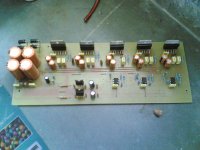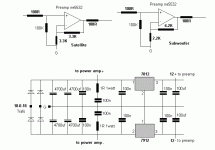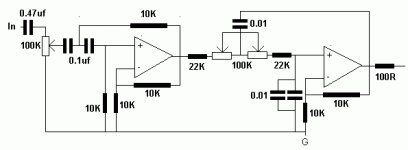now fit the two input filters, the high pass to EQ your response and the low pass to attenuate interference.
You may want more extreme EQ for your bass response, in which case consider adding a separate active filter system.
You may want more extreme EQ for your bass response, in which case consider adding a separate active filter system.
Thank you AndrewT, your advise is working for me. Please find attached picture for my updated power supply & preamp. Satellite preamp is working error free. Very-very low noise is there at full volume but acceptable. Now result is Satellite system is sounding warm & strong. Treble is sharp & crispy. Can I make it soft ? Or is it fine ?
Subwoofer preamp has some noise. Prior to this I used gain resistor 6.2K+1K. The noise was huge. With 6.2K+2.2K noise reduced but still there. Can I make it noise-free ?
Another question is about input resistor 100R. When should I increase or decrease it's value ?
Subwoofer preamp has some noise. Prior to this I used gain resistor 6.2K+1K. The noise was huge. With 6.2K+2.2K noise reduced but still there. Can I make it noise-free ?
Another question is about input resistor 100R. When should I increase or decrease it's value ?
Attachments
Hi,
you could try dropping the 6k2 (+11.6dB) NFB resistor to 4k7 (+9.9dB).
The pre-amp has a response down to DC. The power amplifier must be protected to ensure you cannot damage your speakers.
You still need to add at least an RF filter (low pass) to the input of the pre-amp.
Decide what RC time constant you want to try and then that 100r (or another value) combined with a capacitor to ground will roll off the upper frequencies.
I prefer my sources to have a wider passband than my power amps.
I use RC~90ms and 0.7us for power amp. This then requires 150 to 200ms and 0.3 to 0.4us for the source to match my preferred filtering. 1k0 and 330pF + 2u2F and 82k satisfy both pre-amp filters.
you could try dropping the 6k2 (+11.6dB) NFB resistor to 4k7 (+9.9dB).
The pre-amp has a response down to DC. The power amplifier must be protected to ensure you cannot damage your speakers.
You still need to add at least an RF filter (low pass) to the input of the pre-amp.
Decide what RC time constant you want to try and then that 100r (or another value) combined with a capacitor to ground will roll off the upper frequencies.
I prefer my sources to have a wider passband than my power amps.
I use RC~90ms and 0.7us for power amp. This then requires 150 to 200ms and 0.3 to 0.4us for the source to match my preferred filtering. 1k0 and 330pF + 2u2F and 82k satisfy both pre-amp filters.
You still need to add at least an RF filter (low pass) to the input of the pre-amp.
And it works again. Thanks. ( Rf filter can be find at esp's tda2050 project.)
With reference to post # 41
Please find attached file. Is it this, you wanted to advice ? I don't need summing opamp. The input of preamp is already low-passed signal. I need to cut-off very low-frequencies & adjustment. Phase can be swapping at speaker terminal.
now fit the two input filters, the high pass to EQ your response and the low pass to attenuate interference.
Please find attached file. Is it this, you wanted to advice ? I don't need summing opamp. The input of preamp is already low-passed signal. I need to cut-off very low-frequencies & adjustment. Phase can be swapping at speaker terminal.
Attachments
- Status
- Not open for further replies.
- Home
- Amplifiers
- Chip Amps
- Gain, Preamp, Efficient Driver


